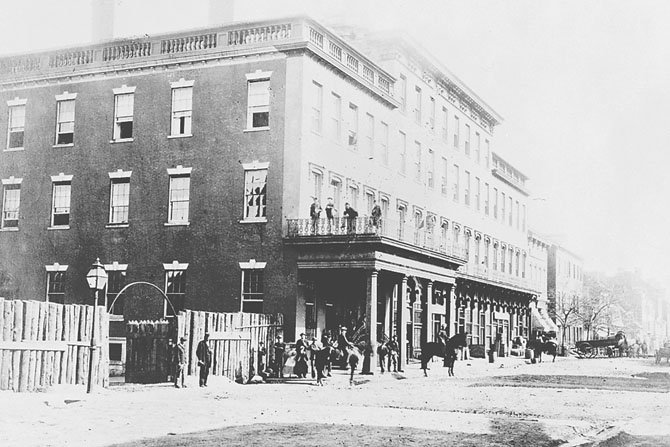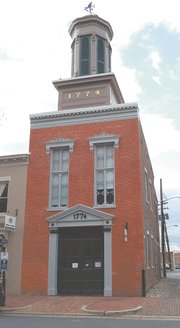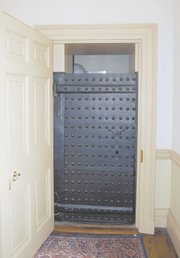1860: This Civil War-era photograph shows the original Bank of Alexandria building on the corner. James Green turned the structure into a hotel in the 1840s and built the four-story addition on the right in 1855. Library of Congress
A fairly nondescript building sits on southeast corner of North Fairfax and Cameron Streets. It’s a bit taller than the others nearby, and forms a quiet bookend for the distinctive Carlyle House next door. It’s anonymity, however, belies its rich history.
The Bank of Alexandria, established in 1792, moved from its original offices on Cameron Street to this building at 133 North Fairfax Street in 1807. Philip Fendall was the first president, and he was succeeded by William Herbert, a son-in-law of John Carlyle and a mayor of Alexandria. George Washington was an early stockholder.
The bank failed in 1834, a victim of Andrew Jackson’s Bank War. James Green converted the building into the Mansion House Hotel in the late 1840s, and built an addition in 1855 that ingloriously blocked the view of the Carlyle House from Fairfax Street. During the Civil War, the Union Army used the hotel as a hospital, as it did with many large buildings in the city. Again a hotel after the war, new owners in the 1880s renamed it the Braddock House. Another conversion near the turn of the 20th century made it the Carlyle Apartments, and gradually some spaces became offices.
The Northern Virginia Park Authority bought the building complex in 1970 as part of its planned Carlyle House restoration. The Authority hoped to raze everything in order to feature the Carlyle House. However, a debate within the city ensued about the demolition — “Wreck Peter to Save Paul?” was the Washington Post headline in December 1970. According to Alexandria developer Rodger Digilio, the park authority ultimately gained permission to proceed since the building apparently did not predate 1847 and thus qualify for preservation. “It wasn’t until demolition had started in 1973 that it became clear that the bank fragment was much older,” Digilio explained recently. “A records search revealed it had been built in 1807, so it was saved.”
Digilio’s firm, OTV, Inc., redeveloped the building in the 1970s and has a 40-year lease on the building. It is now a mix of office spaces and co-op apartments.
By Michael K. Bohn
Gazette Packet


